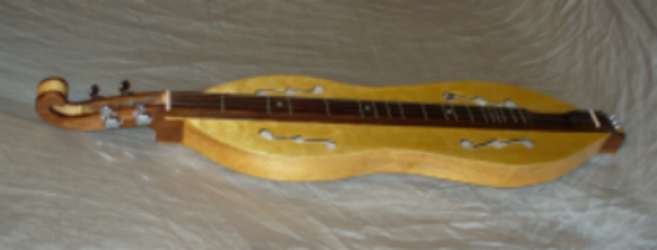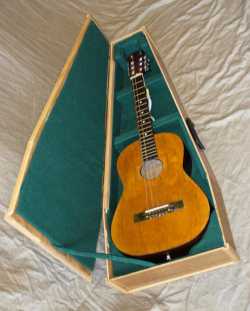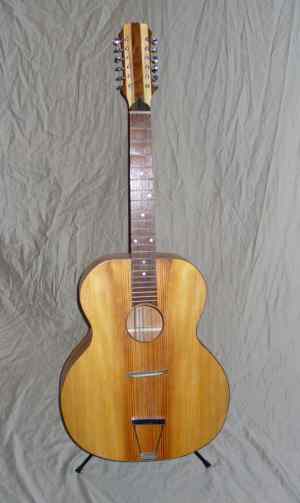 My first instrument - an over-built ukulele. The
wood is ponderosa pine and flame maple, with walnut
trim. The neck is made of laminated maple and walnut. Nut and bridge are
bone, the fingerboard is walnut. A similar formula of wood was used in most
of these instruments.
I had to repair a crack that appeared in the top near the bridge.
You can't see it, but I mention it in the interests of full disclosure.
My first instrument - an over-built ukulele. The
wood is ponderosa pine and flame maple, with walnut
trim. The neck is made of laminated maple and walnut. Nut and bridge are
bone, the fingerboard is walnut. A similar formula of wood was used in most
of these instruments.
I had to repair a crack that appeared in the top near the bridge.
You can't see it, but I mention it in the interests of full disclosure.
 The next I built was this lap dulcimer. It's my
best sounding instrument, and maybe the best looking.
It is made of maple, walnut, and again, a pine top. A simple fun
thing to play. I've seen real experts doing all sorts of fretting and
chording and intricate fingerwork. I am not a real expert.
The next I built was this lap dulcimer. It's my
best sounding instrument, and maybe the best looking.
It is made of maple, walnut, and again, a pine top. A simple fun
thing to play. I've seen real experts doing all sorts of fretting and
chording and intricate fingerwork. I am not a real expert.
 This was a beat-up, cheap old acoustic that I
reworked into a functional octave mandolin. I got the idea for this project from the
website of Dennis Havlena.
the guitar originally had a red epoxy
finish which had become bubbled and mold-stained. I sanded and scraped it off.
The final surface is the top layer of veneer on the plywood top. There was also a set of
hummingbird-style pick guards flanking the soundhole. I may yet restore them,
but as yet it hasn't seemed worth the trouble.
This was a beat-up, cheap old acoustic that I
reworked into a functional octave mandolin. I got the idea for this project from the
website of Dennis Havlena.
the guitar originally had a red epoxy
finish which had become bubbled and mold-stained. I sanded and scraped it off.
The final surface is the top layer of veneer on the plywood top. There was also a set of
hummingbird-style pick guards flanking the soundhole. I may yet restore them,
but as yet it hasn't seemed worth the trouble.
The patches around the soundhole were necessary due to
mouse damage. I removed pounds of mouse nest from the body.
The tension of extra strings required the use of a sort of sound
post. I need
to find lighter strings if I want to keep the bridge from bellying out.
Maybe even nylon/gut strings. I wonder how that would sound string in
double courses...
I built this case for the instrument out of panelling scraps.
 This twelve-string acoustic has gotten a lot
mellower in the two years since I built it. The
hardware came from a
trashed instrument I got cheap on ebay. The top is
ponderosa pine, the back and sides are birch. Neck is
a maple-walnut laminate. The bridge is made of a dark grey,
super-hard oak. I have been led to believe that the color and
consistancy of the wood are due to minerals it absorbed while under water.
This twelve-string acoustic has gotten a lot
mellower in the two years since I built it. The
hardware came from a
trashed instrument I got cheap on ebay. The top is
ponderosa pine, the back and sides are birch. Neck is
a maple-walnut laminate. The bridge is made of a dark grey,
super-hard oak. I have been led to believe that the color and
consistancy of the wood are due to minerals it absorbed while under water.
 ( Here's a banjo I built for my nephew, though I'm
playing it here in the photo.
The head is a $2 drumhead from a junk shop. The
tensioners are $0.07 pan-
head screws. The wood is all found scrap: oak neck,
pine and plywood donuts for the pot. The tailpiece is
cut from a tin can. The only thing I bought new was a set of
$5 tuners from the supply catalog. It doesn't have a
lot of volume but it has a pleasant sound.
( Here's a banjo I built for my nephew, though I'm
playing it here in the photo.
The head is a $2 drumhead from a junk shop. The
tensioners are $0.07 pan-
head screws. The wood is all found scrap: oak neck,
pine and plywood donuts for the pot. The tailpiece is
cut from a tin can. The only thing I bought new was a set of
$5 tuners from the supply catalog. It doesn't have a
lot of volume but it has a pleasant sound.
 Here's a tin canjo I built one afternoon. It's
pretty crappy, but I can get a little blues riff out
of it.
Here's a tin canjo I built one afternoon. It's
pretty crappy, but I can get a little blues riff out
of it.